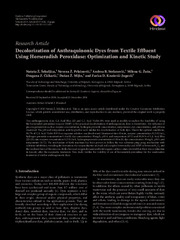Decolorization of anthraquinonic dyes from textile effluent using horseradish peroxidase: Optimization and kinetic study
2015
Аутори
Šekuljica, Nataša
Prlainović, Nevena

Stefanović, Andrea

Žuža, Milena

Čičkarić, Dragana Z.

Mijin, Dušan

Knežević-Jugović, Zorica

Чланак у часопису (Објављена верзија)
Метаподаци
Приказ свих података о документуАпстракт
Two anthraquinonic dyes, C.I. Acid Blue 225 and C.I. Acid Violet 109, were used as models to explore the feasibility of using the horseradish peroxidase enzyme (HRP) in the practical decolorization of anthraquinonic dyes in wastewater. The influence of process parameters such as enzyme concentration, hydrogen peroxide concentration, temperature, dye concentration, and pH was examined. The pH and temperature activity profiles were similar for decolorization of both dyes. Under the optimal conditions, 94.7% of C.I. Acid Violet 109 from aqueous solution was decolorized (treatment time 15 min, enzyme concentration 0.15 IU/mL, hydrogen peroxide concentration 0.4 mM, dye concentration 30 mg/L, pH 4, and temperature 24°C) and 89.36% of C.I. Acid Blue 225 (32 min, enzyme concentration 0.15 IU/mL, hydrogen peroxide concentration 0.04 mM, dye concentration 30 mg/L, pH 5, and temperature 24°C). The mechanism of both reactions has been proven to follow the two substrate ping-pong mechanism with su...bstrate inhibition, revealing the formation of a nonproductive or dead-end complex between dye and HRP or between Hand the oxidized form of the enzyme. Both chemical oxygen demand and total organic carbon values showed that there was a reduction in toxicity after the enzymatic treatment. This study verifies the viability of use of horseradish peroxidase for the wastewaters treatment of similar anthraquinonic dyes.
Извор:
Scientific World Journal, 2015, 2015Издавач:
- Hindawi Limited
Финансирање / пројекти:
- Развој нових инкапсулационих и ензимских технологија за производњу биокатализатора и биолошки активних компонената хране у циљу повећања њене конкурентности, квалитета и безбедности (RS-MESTD-Integrated and Interdisciplinary Research (IIR or III)-46010)
- Проучавање синтезе, структуре и активности органских једињења природног и синтетског порекла (RS-MESTD-Basic Research (BR or ON)-172013)
Колекције
Институција/група
Tehnološko-metalurški fakultetTY - JOUR AU - Šekuljica, Nataša AU - Prlainović, Nevena AU - Stefanović, Andrea AU - Žuža, Milena AU - Čičkarić, Dragana Z. AU - Mijin, Dušan AU - Knežević-Jugović, Zorica PY - 2015 UR - http://TechnoRep.tmf.bg.ac.rs/handle/123456789/2879 AB - Two anthraquinonic dyes, C.I. Acid Blue 225 and C.I. Acid Violet 109, were used as models to explore the feasibility of using the horseradish peroxidase enzyme (HRP) in the practical decolorization of anthraquinonic dyes in wastewater. The influence of process parameters such as enzyme concentration, hydrogen peroxide concentration, temperature, dye concentration, and pH was examined. The pH and temperature activity profiles were similar for decolorization of both dyes. Under the optimal conditions, 94.7% of C.I. Acid Violet 109 from aqueous solution was decolorized (treatment time 15 min, enzyme concentration 0.15 IU/mL, hydrogen peroxide concentration 0.4 mM, dye concentration 30 mg/L, pH 4, and temperature 24°C) and 89.36% of C.I. Acid Blue 225 (32 min, enzyme concentration 0.15 IU/mL, hydrogen peroxide concentration 0.04 mM, dye concentration 30 mg/L, pH 5, and temperature 24°C). The mechanism of both reactions has been proven to follow the two substrate ping-pong mechanism with substrate inhibition, revealing the formation of a nonproductive or dead-end complex between dye and HRP or between Hand the oxidized form of the enzyme. Both chemical oxygen demand and total organic carbon values showed that there was a reduction in toxicity after the enzymatic treatment. This study verifies the viability of use of horseradish peroxidase for the wastewaters treatment of similar anthraquinonic dyes. PB - Hindawi Limited T2 - Scientific World Journal T1 - Decolorization of anthraquinonic dyes from textile effluent using horseradish peroxidase: Optimization and kinetic study VL - 2015 DO - 10.1155/2015/371625 ER -
@article{
author = "Šekuljica, Nataša and Prlainović, Nevena and Stefanović, Andrea and Žuža, Milena and Čičkarić, Dragana Z. and Mijin, Dušan and Knežević-Jugović, Zorica",
year = "2015",
abstract = "Two anthraquinonic dyes, C.I. Acid Blue 225 and C.I. Acid Violet 109, were used as models to explore the feasibility of using the horseradish peroxidase enzyme (HRP) in the practical decolorization of anthraquinonic dyes in wastewater. The influence of process parameters such as enzyme concentration, hydrogen peroxide concentration, temperature, dye concentration, and pH was examined. The pH and temperature activity profiles were similar for decolorization of both dyes. Under the optimal conditions, 94.7% of C.I. Acid Violet 109 from aqueous solution was decolorized (treatment time 15 min, enzyme concentration 0.15 IU/mL, hydrogen peroxide concentration 0.4 mM, dye concentration 30 mg/L, pH 4, and temperature 24°C) and 89.36% of C.I. Acid Blue 225 (32 min, enzyme concentration 0.15 IU/mL, hydrogen peroxide concentration 0.04 mM, dye concentration 30 mg/L, pH 5, and temperature 24°C). The mechanism of both reactions has been proven to follow the two substrate ping-pong mechanism with substrate inhibition, revealing the formation of a nonproductive or dead-end complex between dye and HRP or between Hand the oxidized form of the enzyme. Both chemical oxygen demand and total organic carbon values showed that there was a reduction in toxicity after the enzymatic treatment. This study verifies the viability of use of horseradish peroxidase for the wastewaters treatment of similar anthraquinonic dyes.",
publisher = "Hindawi Limited",
journal = "Scientific World Journal",
title = "Decolorization of anthraquinonic dyes from textile effluent using horseradish peroxidase: Optimization and kinetic study",
volume = "2015",
doi = "10.1155/2015/371625"
}
Šekuljica, N., Prlainović, N., Stefanović, A., Žuža, M., Čičkarić, D. Z., Mijin, D.,& Knežević-Jugović, Z.. (2015). Decolorization of anthraquinonic dyes from textile effluent using horseradish peroxidase: Optimization and kinetic study. in Scientific World Journal Hindawi Limited., 2015. https://doi.org/10.1155/2015/371625
Šekuljica N, Prlainović N, Stefanović A, Žuža M, Čičkarić DZ, Mijin D, Knežević-Jugović Z. Decolorization of anthraquinonic dyes from textile effluent using horseradish peroxidase: Optimization and kinetic study. in Scientific World Journal. 2015;2015. doi:10.1155/2015/371625 .
Šekuljica, Nataša, Prlainović, Nevena, Stefanović, Andrea, Žuža, Milena, Čičkarić, Dragana Z., Mijin, Dušan, Knežević-Jugović, Zorica, "Decolorization of anthraquinonic dyes from textile effluent using horseradish peroxidase: Optimization and kinetic study" in Scientific World Journal, 2015 (2015), https://doi.org/10.1155/2015/371625 . .


